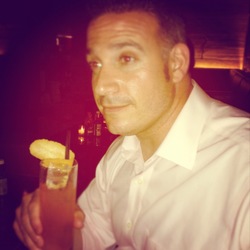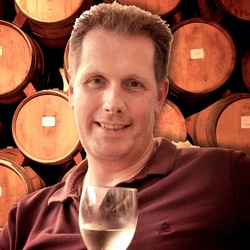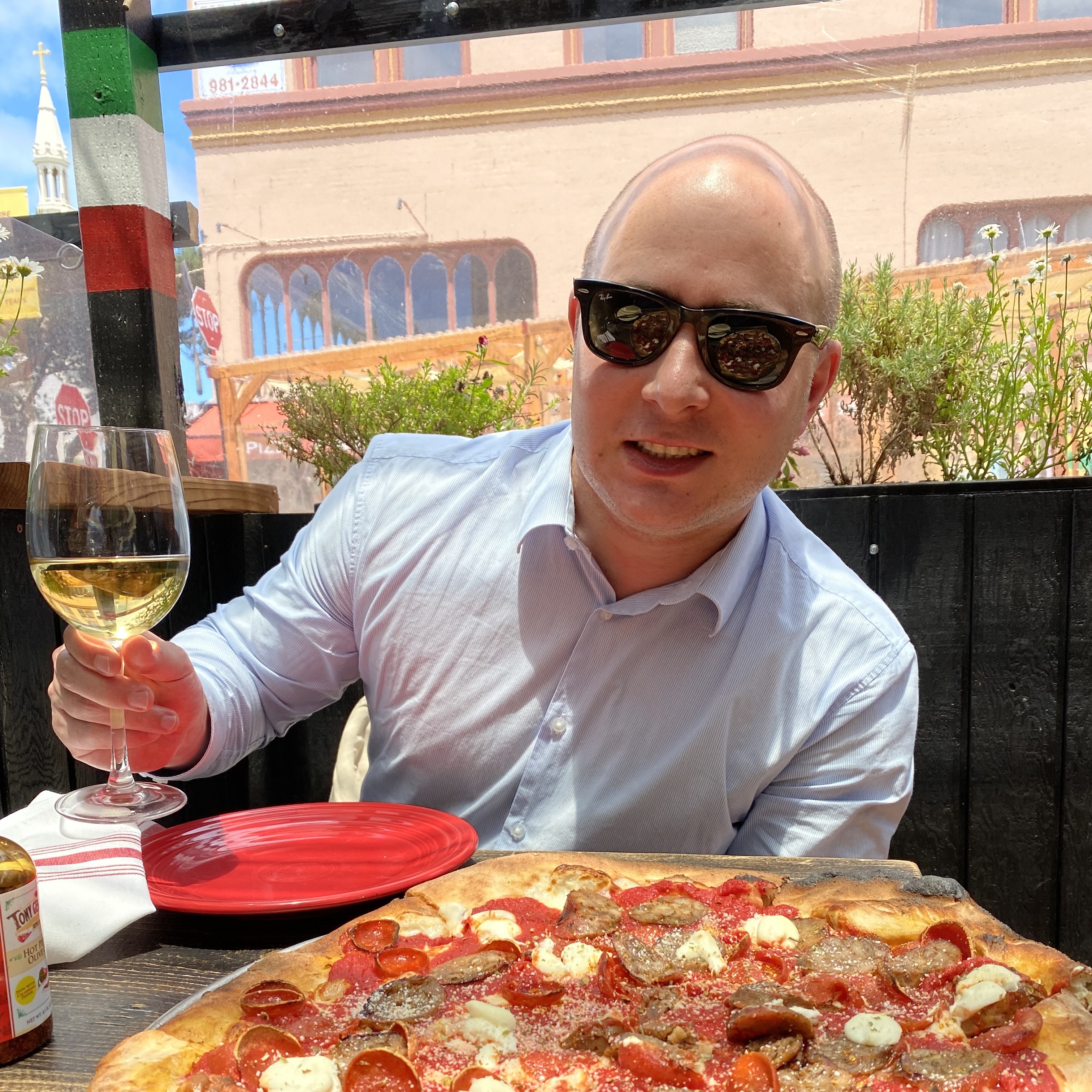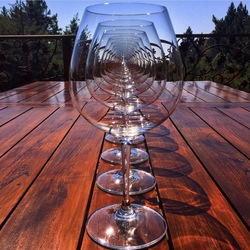Love Over Money
Sans Liege
The Offering Syrah Blend
We opened this yesterday, and it has improved with exposure to air. It’s become more plush, open knit and inviting, while not being over/bearing. Lovely spice-box and cedar nose leads into rich cherries on the mid-palate. Medium weight, with medium sweetness, which finishes with roundness and moderate acidity. Very enjoyable, and love the label! — 6 years ago


Rene Rostaing
Ampodium Côte-Rôtie Syrah 2010
Love this Rostaing Syrah created from 12 or 13 different vineyards. The style encompasses everything thing I love about Northern Rhône. At $50-$55, their 2010 vintage of Ampodium pushes quality close to their much more expensive single vineyard bottling for a 1/3 of the price.
It’s round and elegant. Lightly roasted, creamy dark fruits, used expresso grounds, savory meats, just a touch of bacon fat, soft, understated minerals, dry top soil with dark withering & fresh dark florals. The round and beautiful. The finish glides over the palate with persistence and puts a smile on your face. It was a magnificat pair with my Short Ribs and Yukon Gold Horseradish Potato Purée.
— 6 years ago
Château Léoville Barton
Saint-Julien Red Bordeaux Blend 2003
I love barton so I might be partial here. Dark ruby and full bodied. Decanted for 45 minutes and a big hit. Powerful wine but not over powering like barton tends to do. Rich and well balanced with smoke, currant and little bit of leather. This bottle went fast! — 7 years ago
Colgin Cellars
IX Estate Napa Valley Red Blend 2007
I completely forgot to post this. My brother from another mother Kirk Alexander uncorked these 2 Absolutely Phenomenal 100 point beauties for us to enjoy just because I came over!!!!!! ! Damn., I’ve got to go to his house more often!!!!!! All kidding aside., we were celebrating Veronica’s (his beautiful wife) birthday and what a truly special Evening.it was. There’s nothing better than uncorking a special bottle with friends that have become like family.
We love you Veronica!!! And put up with Kirk just because of you🤣😜🤣
— 8 years ago
Armand de Brignac
Ace of Spades Brut Rosé Champagne Blend
Was this an awesome Rose? Yes. But not worth the money. Take away the Jay Z label and you just have a very good but over priced rose not worth more than 100 bucks — 8 years ago
Venge Vineyards
Silencieux Napa Valley Cabernet Sauvignon 2015
Last bottle! Rated previously!
Such a delicious wine! I have thoroughly enjoyed sampling this over the past few years. Just a little different at every stage! ☺️
BlackBerry, Blueberry, plum, vanilla, cocoa powder, molasses, and smoke ( characteristic I love)! — 5 years ago
Kongsgaard
Napa Valley Chardonnay 2013
I’ve been savoring this bottle over several months using my Coravin. Sadly, finally finished it off. Just love tasting this golden beauty open up in the glass. Can’t wait to start on another bottle! — 6 years ago
R. López de Heredia
Viña Gravonia Crianza Rioja Viura 2005
Nose has oxidized honey, green herbs, hazelnut, apricot, faint-light petrol, eucalyptus, gardenia blossom, all powerful, concentrating and invigorating.
Palate has honey tea with oak sawdust, cedar plank, beautiful saline minerality, candlewax, great acidity bite that comes in late, such extravagance.
We've been enjoying these Heredia crianzas for many years, but they do need time to settle in and we're still drinking these too young, but damn they are guilty pleasures. We really fell in love with the Blanc many years ago, drinking young then patiently waiting several years, wow what an evolution!
Decanted 2+hrs, drink now or enjoy over the next 3-5 years without concern.
$22, yes I know that reads like a crazy price, because it is, only patience is required! — 6 years ago
Gargiulo Vineyards
Money Road Ranch Cabernet Sauvignon 2007
Honeymoon wine, with our 7yr anniversary two weeks away. 45min decant. Deep, dark purple color. Black cherry, subtle blueberry, and oak dominate the nose. Great fruit, big tannins. Powerful wine, but refined and high quality. Finish seems to never end. Love Gargiulo!!!!! — 7 years ago
Château Brane-Cantenac
Grand Cru Classé en 1855 Margaux Red Bordeaux Blend 2005
I have a six-pack of this 05. I thought after 10 years in bottle, it would be interesting to check in on its evolution. While tasty, I’ll wait another 8-10 to open another. Even after 2-3 hours in the decanter, it’s still a very young adolescent. On the nose, slightly sour blackberries & dark cherries, dark currants, baked black plum, haunting blue fruits, anise, whiff of spice, steeped tea, dry stones, dry crushed rocks with dry top soil, caramel, vanilla with fresh & dry red florals. The body is thick & full. Tannins are starting to round out. It’s velvety on the palate. The fruits are; bright, fresh & ripe and really show the greatness of the 05 vintage. Dark currants, blackberries, dark cherries, baked black plum, haunting blue fruits, baked strawberries, cherries, raspberries on the long set, dark spice, clay & loamy dry top soil with crushed rocks, dry stones, cigar with ash, graphite, dry stems, slight herbaceous character, mint, used leather, clove, caramel, vanilla, fresh & dry red florals with violets. The round acidity is about perfect. The structure and length are still strong. The balance is in harmony. As for the long finish, it’s lush, ruby, rich and well polished. Photos of; Chateau Brane Cantenac, large wood vats, Henri Lurton and Estate vines. Producer notes and history...Chateau Brane Cantenac began in the early 17th century. At the time, the estate was known as Domaine Guilhem Hosten. Even that far back, wine was produced from the property. In fact, the wine was so highly regarded it was one of the more expensive wines in Bordeaux. It sold for almost as much money as Brane Mouton. This is interesting because of who went on to buy the vineyard in the 1800’s. The Baron of Brane, also known as “Napoleon of the Vineyards”, purchased the Chateau in 1833. At the time of the sale, the estate was called Chateau Gorce-Guy. To get the funds needed to purchase the Margaux vineyard, the Baron sold what is now called Mouton Rothschild, which was at the time of the sale, known as Chateau Brane-Mouton. Not such a good move with hundreds of years in hindsight! In 1838, the Baron renamed property taking his name and the name of the sector where the vineyards were located and called it Chateau Brane Cantenac. The Chateau later passed to the Roy family, who were well-known in the Margaux appellation in those days, as they owned Chateau d’issan. Moving ahead to 1920, the Societe des Grands Crus de France, a group of merchants and growers that owned several chateaux located in the Medoc including; Chateau Margaux, Chateau Giscours, and Chateau Lagrange in St. Julien, purchased Chateau Brane Cantenac. Five years later, M. Recapet and his son-in-law, François Lurton, took over Brane Cantenac along with Chateau Margaux. Lucien Lurton (the son of François Lurton) inherited Brane Cantenac in 1956. Today, the estate is still in the hands of the Lurton family. Brane Cantenac is owned and run by Henri Lurton. After being given the responsibility of managing Brane Cantenac, it was under the direction of Henri Lurton that large portions of the vineyard were replanted. Vine densities were increased, the drainage systems were improved and the plantings were also, slowly changed. The vineyard of Brane Cantenac is planted to 55% Cabernet Sauvignon, 40% Merlot, 4.5% Cabernet Franc and .5% Carmenere. Carmenere was used for the first time in the 2011 vintage. The only other Chateau I know that still uses Carmenere is Clerc Milon. The 75 hectare Left Bank vineyard of Brane Cantenac is essentially unchanged since it earned Second Growth status in the 1855 Classification. At least that is the case with the 45 hectares used to produce the Grand Vin of Brane Cantenac. Those 45 hectares are planted surrounding the Chateau. Those vines are located just in front of the Cantenac plateau and are the best terroir that Brane Cantenac owns. They have other parcels, which are further inland and much of those grapes are placed into their second wine, Le Baron de Brane. Those additional hectares can be divided into 3 main sections. Behind the Chateau, they have 15 hectares of vines on gravel and sand, 10 hectares across the road with sand, gravel and iron and a 13 hectare parcel with gravel called Notton, which is used for their second wine. The vineyard is planted to a vine density that ranges from 6,666 vines per hectare on the plateau and up to 8,000 vines per hectare for the vines located behind chateau, in their sandier soils. The higher levels of vine density are always found in the newer plantings. The terroir of Brane Cantenac consists of deep gravel, sand and clay soil. Experiments in the vineyards are currently looking at becoming more organic in their vineyard management. Today, more than 25% of Brane Cantenac is farmed using organic farming techniques. It is expected that over time, the amount of hectares farmed with organic methods will be increased. Brane Cantenac has gone through 2 relatively recent modernization’s in 1999, when they added began adding the first of their smaller vats to allow for parcel by parcel vinification and then again in 2015 when they completed a much more complete renovation of their cellars and vat rooms. While Brane Cantenac is a traditional producer, they are no stranger to technology as they were one of the first estates to embrace optical grape sorting machines. In very wet vintages, they can also use reverse osmosis. To produce the wine of Chateau Brane Cantenac, the wine is vinified in a combination of temperature controlled, traditional, 22 oak vats, 18 concrete tanks and 20 stainless steel vats that vary in size from 40 hectoliters all the way up to 200 hectoliters, which allows for parcel by parcel vinification. 40% of the fermentation takes place in the oak vats. The oldest vines are vinified in vats that are selected to allow for separate parcel by parcel vinification. The younger vines are vinified more often together in the same vats. However, the Carmenere is entirely micro-vinified, meaning that those grapes were completely vinified in barrel, using micro-vinification techniques. This can also happen because the amount of grapes produced is so small. Some vats can be co-inoculated, meaning they go through alcoholic fermentation and malolactic fermentation simultaneously. At Chateau Brane Cantenac, malolactic fermentation takes place in a combination of French oak tanks and barrels. The wine of Brane Cantenac is aged in an average of 60% new, French oak barrels for 18 months before bottling. The initial 2 months of aging is done with the wine on its lees, which adds more depth to the wine. There second wine is Le Baron de Brane. Le Baron de Brane is not new. In fact, previously, the second wine went under the name of Chateau Notton, which took its name from one of the main parcels where the grapes were planted. During the late 1950’s and into the 1960’s, having a second wine was important as the estate declassified 3 vintages, due to extremely poor, weather conditions in 1956, 1960 and 1963. Production of Chateau Brane Cantenac is about 11,000 cases per year. — 7 years ago

Masi
Costasera Amarone della Valpolicella Classico Corvina Blend 2007
Dark.A little weak fruit on the nose. Cherry tobacco dominates. Red and black fruit with cherry over prune tannins well integrated/subtle good length and mouthful but not as lengthy as better amarone. Borderline like/love — 5 years ago
Billecart-Salmon
Brut Rosé Champagne Chardonnay Blend
Now BSR is one of our main Friday 375ml weekend kickoff celebration starters but, tonight is a little different and even more special.
I’ll be a little mysterious and private about it. However, let’s just say it has taken ten years over a long road to achieve a goal of mine but, today I did. So, a mighty BSR cheers with our favorite N/V Rosé Champagne (except Krug Rosé) with the love of my life, Sofia.
All my many notes still apply.
Hope you all have a great weekend and enjoy some nice wine and or spirits. Cheers! 🍾 🥂
Photos of; the House of Billecart Salmon, cellars, barrel room and Grand Cru vineyard. — 6 years ago
Love Over Money
Green Eyes Wolfsgraben Grüner Veltliner
Wine club March 2019. Green apple, pear and lime. Light and zesty. 3.14.19 — 6 years ago
Heitz Cellar
Napa Valley Cabernet Sauvignon 2008
As I evaluate my wine purchases over time, I consider; quality, pleasure and the price of the bottle of wine. Specifically, how good is the wine vs. the price and others that I’ve had that are certainly better wines but cost over $70-$500 more? In this case, are they worth 3 to 14 times more money? I find the answer more often than not, no. I feel this way about the Heitz & Joseph Phelps regular Napa wines over their higher priced wines for sure. And, many other high end producers. This wine was under $35 and it’s delicious without having reached its peak.
On the nose, stewed; blueberries & black plum, strawberries, ripe black raspberries & dark cherries. Black cherry cola, black licorice, limestone minerals, vanilla, cinnamon, light clove & nutmeg, dark rich soil, understated mint with red, dark & blue florals.
The body is medium full, rich and elegant. The tannins are round, fine and nicely resolved. It’s seamless wire to wire. The structure, tension, length and balance are starting to really jell. stewed, ripe; blueberries & black plum, strawberries, ripe black raspberries, creamy raspberries & dark cherries. Black cherry cola, black licorice, limestone minerals, vanilla, cinnamon, light clove & nutmeg, dark spice, dry stems, used leather, tobacco leaf, graphite, touch of mocha & caramel, dark rich soil, understated mint with red, dark & blue florals. The acidity is near perfect. The finish is beautiful and last minutes. Still a lot of life in the 08...another 10 years plus.
Photos of; the side of their tasting room, transiting Winemaker David Heitz. Still disappointed a Napa pioneering family sold to a corporation. Tasting room terrace, old school basket press and a wide shot of the winery & Estate vines. — 7 years ago
Olga Raffault
Les Picasses Chinon Cabernet Franc 2011
Is there a better wine for roast chicken than Loire cabernet franc? Rhetorical question, of course. 2011 so tight, even after two hour decant. It slowly unveils its charms, like Jo Fiennes unwinds Gwen Paltrow in the otherwise forgettable "Shakespeare in Love". Unlike that film, this has staying power. Stash away a case, it will develop beautifully over the next three decades. — 8 years ago

Herman Story
Bolt Cutter Cabernet Sauvignon Blend 2013

Bedrock Wine Co.
Old Vine Zinfandel 2015
Love it. Such an incredible value.
Appearance: Clear and polished ruby/magenta with slight variation to the rim; medium body and legs
Nose: getting some alcohol and smoked meats, earthiness
Taste: Dark red fruit core with good structure and tannins; alcohol is a bit noticeable at the point but should integrate well over the next year or two; some very light and pleasant menthol sort of notes
We paired this with beef Wellington and roasted potatoes smothered in duck fat, gruyere and thyme. It held up beautifully and didn't overtake the dish. We opened 2 hrs before and let it passively decant in bottle - may play around with a hard decant, etc. guessing day 2 for this one will be even better. — 8 years ago


















Ron Siegel
One of my favorite vintages of GL that I have had many times over the last few years. This has been fully mature & still holding showing red & black fruits, cedar, leather, earth, tar, forest floor, licorice & tobacco. One of the reasons why I love older Bordeaux! — 5 years ago